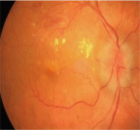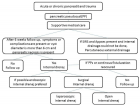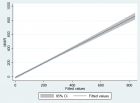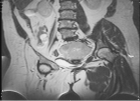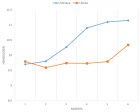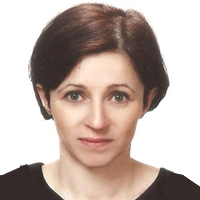Abstract
Research Article
Analysing Average Glandular Dose: A Comprehensive Study Comparing Digital Breast Tomosynthesis with Full-Field Digital Mammography in Oman
Naema Al-Maymani*, Raya Al-Mamari, Subhash Kheruka, Amna Al-Jabri, Noura Al-Makhmari, Sana Al-Rashdi, Huoda Al-Saidi, Anas Al-Balushi and Rashid Al-Sukaiti
Published: 31 March, 2025 | Volume 9 - Issue 1 | Pages: 031-040
Background: Full-field Digital Mammography (FFDM) is essential for the early detection of breast cancer. Digital Breast Tomosynthesis (DBT) has improved cancer diagnosis and reduced false positives in mammography . This study evaluated DRLs for FFDM and DBT at various ranges of Compressed Breast Thickness (CBT).
Material and methods: We evaluated the parameters like Average Glandular Dose (AGD), kVp, mAs, Entrance Surface Dose (ESD), and CBT in a retrospective analysis of FFDM and DBT. We computed the mean, median, range, and 75th percentile for Craniocaudal (CC) and Mediolateral Oblique (MLO) views at various breast thicknesses.
Results: The DRLs were 0.70 mGy to 2.55 mGy for FFDM and 0.94 mGy to 3.67 mGy for DBT for breast thickness in the range from 20 mm to 89 mm.
Conclusion: This analysis revealed that DRLs were significantly lower than international benchmarks . Mammography radiation dose optimisation enhances diagnostic accuracy and patient safety.
Read Full Article HTML DOI: 10.29328/journal.jro.1001077 Cite this Article Read Full Article PDF
References
- Marinovich ML, Hunter KE, Macaskill P, Houssami N. Breast cancer screening using tomosynthesis or mammography: a meta-analysis of cancer detection and recall. JNCI Cancer Spectrum. 2018;110(9):942-949. Available from: https://doi.org/10.1093/jnci/djy121
- Friedewald SM, Rafferty EA, Rose SL, Durand MA, Plecha DM, Greenberg JS, et al. Breast cancer screening using tomosynthesis in combination with digital mammography. JAMA. 2014;311(24):2499-2507. Available from: http://doi.org/10.1001/jama.2014.6095
- Gennaro G, Bernardi D, Houssami N. Radiation dose with digital breast tomosynthesis compared to digital mammography: per-view analysis. Eur Radiol. 2018;28(2):573-581. Available from: https://doi.org/10.1007/s00330-017-5024-4
- Asbeutah AM, AlMajran AA, Brindhaban A, Asbeutah SA. Comparison of radiation doses between diagnostic full-field digital mammography (FFDM) and digital breast tomosynthesis (DBT): a clinical study. J Med Radiat Sci. 2020;67(3):185-192. Available from: https://doi.org/10.1002/jmrs.405
- Vañó E, Miller DL, Martin CJ, Rehani MM, Kang K, Rosenstein M, Ortiz-López P, Mattsson S, Padovani R, Rogers A. ICRP publication 135: diagnostic reference levels in medical imaging. Ann ICRP. 2017;46(1):1-144. Available from: https://doi.org/10.1177/0146645317717209
- Boone JM. Glandular breast dose for monoenergetic and high-energy X-ray beams: Monte Carlo assessment. Radiology. 1999;213(1):23-37. Available from: https://doi.org/10.1148/radiology.213.1.r99oc3923
- Liu Q, Suleiman ME, McEntee MF, Soh BP. Diagnostic reference levels in digital mammography: a systematic review. J Radiol Prot. 2022;42(1):011503. Available from: https://doi.org/10.1088/1361-6498/ac4214
- Suleiman M, Brennan P, McEntee M. Mean glandular dose in digital mammography: a dose calculation method comparison. J Med Imaging. 2017;4(1):013502. Available from: https://doi.org/10.1117/1.JMI.4.1.013502
- Acho S, Boonzaier W, Nel I. Exposure parameters of mammograms with and without mass lesions from a South African breast care centre. Radiat Prot Dosimetry. 2017;177(3):348-355. Available from: https://doi.org/10.1093/rpd/ncx053
- Boone JM. Molybdenum, rhodium, and tungsten anode spectral models using interpolating polynomials with application to mammography. Med Phys. 1997;24(12):1863-74. Available from: https://doi.org/10.1118/1.598100
- Boone JM. Normalized glandular dose (DgN) coefficients for arbitrary x-ray spectra in mammography: Computer-fit values of Monte Carlo derived data. Med Phys. 2022;29(5):869-875. Available from: https://doi.org/10.1118/1.1472499
- Samara ET, Tsapaki V, Sramek D. Dose management software implementation in mammography. Phys Med. 2019;68:88-95. Available from: https://doi.org/10.1016/j.ejmp.2019.11.008
- Østerås BH, Skaane P, Gullien R, Martinsen ACT. Average glandular dose in paired digital mammography and digital breast tomosynthesis acquisitions in a population-based screening program: effects of measuring breast density, air kerma, and beam quality. Phys Med Biol. 2018;63(3):035006. Available from: https://doi.org/10.1088/1361-6560/aaa614
- Parmaksız A, Ataç GK, Bulur E, İnal T, Alhan A. Average glandular doses and national diagnostic reference levels in mammography examinations in Turkey. Radiat Prot Dosimetry. 2020;190(1):100-107. Available from: https://doi.org/10.1093/rpd/ncaa080
- Sulieman A, Serhan O, Al-Mohammed HI, Mahmoud MZ, Alkhorayef M, Alonazi B, Manssor E, Yousef A. Estimation of cancer risks during mammography procedure in Saudi Arabia. Saudi J Biol Sci. 2018;26(6):1107-1111. Available from: https://doi.org/10.1016/j.sjbs.2018.10.005
- Suleiman M, McEntee M, Cartwright L, Diffey J, Brennan P. Diagnostic reference levels for digital mammography in New South Wales. J Med Imaging Radiat Oncol. 2016;61(1):48-57. Available from: https://doi.org/10.1111/1754-9485.12540
- Mohd Norsuddin N, Segar S, Ravintaran R, Mohd Zain N, Abdul Karim MK. Local diagnostic reference levels for full-field digital mammography and digital breast tomosynthesis in a tertiary hospital in Malaysia. Healthcare (Basel). 2022;10(10):1917. Available from: https://doi.org/10.3390/healthcare10101917
- Abdulwahid Noor K, Mohd Norsuddin N, Abdul Karim MK, Che Isa IN, Alshamsi W. Estimating local diagnostic reference levels for mammography in Dubai. Diagnostics. 2024;14(1):8. Available from: https://doi.org/10.3390/diagnostics14010008
- Physica Medica. Physica Medica: European Journal of Medical Physics. 2024. Available from: https://doi.org/10.1016/j.ejmp.2024.104230
- Vañó E, Miller DL, Martin CJ, Rehani MM, Kang K, Rosenstein M, Ortiz-López P, Mattsson S, Padovani R, Rogers A. ICRP publication 135: diagnostic reference levels in medical imaging. Ann ICRP. 2017;46(1):1-144. Available from: https://doi.org/10.1177/0146645317717209
- Movik E, Dalsbø TK, Fagelund BC, Friberg EG, Håheim LL, Skår Å. Digital breast tomosynthesis with Hologic 3D mammography Selenia Dimensions system for use in breast cancer screening: A single technology assessment. Knowledge Centre for the Health Services at The Norwegian Institute of Public Health (NIPH). 2017. Available from: https://pubmed.ncbi.nlm.nih.gov/29553669/
- van Engen R, van Woudenberg S, Bosmans H, Young M, Thijssen K. European protocol for the quality control of the physical and technical aspects of mammography screening. 2006. Available from: https://www.researchgate.net/publication/233412600_The_European_protocol_for_the_quality_control_of_the_physical_and_technical_aspects_of_mammography_screening
- van Engen R, van Woudenberg S, Bosmans H, Young M, Thijssen K. European protocol for the quality control of the physical and technical aspects of mammography screening chapter, 2b digital mammography. 2017.
- van Engen RE, Bosmans H, Bouwman RW, Dance DR. Protocol for the quality control of the physical and technical aspects of digital breast tomosynthesis systems, version 1.03. 2018.
- Dzidzornu EA, Suleiman ME, Tsapaki V, Samara ET, Sramek D. Mammography diagnostic reference levels (DRLs) in Ghana. Radiography (Lond). 2021;27(2):611-616. Available from: https://doi.org/10.1016/j.radi.2020.11.022
- Mohd Norsuddin N, Segar S, Ravintaran R, Mohd Zain N, Abdul Karim MK. Local diagnostic reference levels for full-field digital mammography and digital breast tomosynthesis in a tertiary hospital in Malaysia. Healthcare (Basel). 2022;10(10):1917. Available from: https://doi.org/10.3390/healthcare10101917
Figures:

Figure 1

Figure 2

Figure 3
Similar Articles
-
A Short Synthesis Concerning Biological Effects and Equivalent Doses in RadiotherapyCyril Voyant*,Daniel Julian. A Short Synthesis Concerning Biological Effects and Equivalent Doses in Radiotherapy. . 2017 doi: 10.29328/journal.jsmt.1001036; 1: 039-045
-
Inter-Observer Variability of a Commercial Patient Positioning and Verification System in Proton TherapyYuanshui Zheng*,Xiaoning Ding. Inter-Observer Variability of a Commercial Patient Positioning and Verification System in Proton Therapy. . 2017 doi: 10.29328/journal.jro.1001004; 1: 031-038
-
Using Mathematical Procedure to Compute the Attenuation Coefficient in Spectrometry FieldMohamed. S. Badawi*,Mohamed Elsaf,Mona. M. Gouda,Abouzeid A Thabet,Ahmed M El-Khatib,Mahmuod I Abbas,Kholud. S. Almugren. Using Mathematical Procedure to Compute the Attenuation Coefficient in Spectrometry Field. . 2017 doi: 10.29328/journal.jro.1001003; 1: 022-030
-
Empirical formulae for calculating γ-ray detectors effective solid angle ratioMohamed. S. Badawi*,Ahmed M El Khatib,Mohamed A Elzaher,Mona M Gouda,Abouzeid A Thabet,Mahmoud I Abbas,Kholud S Almugren. Empirical formulae for calculating γ-ray detectors effective solid angle ratio. . 2017 doi: 10.29328/journal.jro.1001002; 1: 012-021
-
New Approach for Analysing the Discrepancy of Pretherapeutic Tc-99m and Intra-therapeutic I-131 uptake in Scintigraphies of Thyroid Autonomies using a Parametric 3D Analysis ProgramMaaz Zuhayra,Marlies Marx,Ulrich Karwacik,Yi Zhao,Ulf Lützen*. New Approach for Analysing the Discrepancy of Pretherapeutic Tc-99m and Intra-therapeutic I-131 uptake in Scintigraphies of Thyroid Autonomies using a Parametric 3D Analysis Program. . 2017 doi: 10.29328/journal.jro.1001001; 1: 001-011
-
Photon Absorption characteristics of some selected Enzyme Inhibitors used in Cancer Research in the Energy range 1 keV-100 GeVMustafa Recep Kaçal,Hüseyin Ali Karataş,Ferdi Akman*. Photon Absorption characteristics of some selected Enzyme Inhibitors used in Cancer Research in the Energy range 1 keV-100 GeV. . 2017 doi: 10.29328/journal.jro.1001009; 1: 060-068
-
Radiological evaluation of a Chondromyxoid FibromaAustin Fletcher*,Megan Mastragostino. Radiological evaluation of a Chondromyxoid Fibroma. . 2017 doi: 10.29328/journal.jro.1001008; 1: 054-059
-
Time to Terminate LNT: Radiation Regulators Should Adopt LTJeffry A Siegel*,Bill Sacks,James S Welsh3. Time to Terminate LNT: Radiation Regulators Should Adopt LT. . 2017 doi: 10.29328/journal.jro.1001007; 1: 049-053
-
Metallic Ureteric Stents a cost-effective alternative in the management of Obstructed Distal UretersErich K Lang*. Metallic Ureteric Stents a cost-effective alternative in the management of Obstructed Distal Ureters. . 2017 doi: 10.29328/journal.jro.1001006; 1: 046-048
-
Synthesis, Radioiodination and Biological distribution of 5-(5-(tributylstannyl) benzofuran-2-yl) pyridin-2-amine as an amyloid imaging agentAtteyat A Labib*,Mohsen B Challan. Synthesis, Radioiodination and Biological distribution of 5-(5-(tributylstannyl) benzofuran-2-yl) pyridin-2-amine as an amyloid imaging agent. . 2017 doi: 10.29328/journal.jro.1001013; 1: 087-093
Recently Viewed
-
Transcriptome-wide association study: Opportunity and challenges for cancer studiesKendy Shang,Jingni He*. Transcriptome-wide association study: Opportunity and challenges for cancer studies. Insights Biol Med. 2022: doi: 10.29328/journal.ibm.1001023; 6: 017-021
-
Pharmacological Manipulation of the Aging Pathways to Effect Health Span and Lifespan with Special Reference to SGLT2 Inhibitors as Powerful Anti-aging Agents in HumansDavid K Murdock*. Pharmacological Manipulation of the Aging Pathways to Effect Health Span and Lifespan with Special Reference to SGLT2 Inhibitors as Powerful Anti-aging Agents in Humans. Insights Biol Med. 2024: doi: 10.29328/journal.ibm.1001028; 8: 011-025
-
The motivational factors and adverse events experienced by healthy volunteers donating bone marrow for researchMirella Ejiugwo,Georgina Shaw,Frank Barry,Janusz Krawczyk,Veronica McInerney*. The motivational factors and adverse events experienced by healthy volunteers donating bone marrow for research. Int J Bone Marrow Res. 2019: doi: 10.29328/journal.ijbmr.1001010; 2: 089-096
-
Unveiling the Impostor: Pulmonary Embolism Presenting as Pneumonia: A Case Report and Literature ReviewSaahil Kumar,Karuna Sree Alwa*,Mahesh Babu Vemuri,Anumola Gandhi Ganesh Gupta,Nuthan Vallapudasu,Sunitha Geddada. Unveiling the Impostor: Pulmonary Embolism Presenting as Pneumonia: A Case Report and Literature Review. J Pulmonol Respir Res. 2025: doi: 10.29328/journal.jprr.1001065; 9: 001-005
-
Use of Lactobacillus reuteri DSM 17938 in the treatment of Stage II-III Periodontitis: Longitudinal Study of 36 PatientsAlessandra Laforgia*, Daniela Di Venere, Saverio Capodiferro, Vanja Granberg, Giuseppe Barile, Massimo Corsalini. Use of Lactobacillus reuteri DSM 17938 in the treatment of Stage II-III Periodontitis: Longitudinal Study of 36 Patients. J Clin Adv Dent. 2024: doi: 10.29328/journal.jcad.1001039; 8: 001-008
Most Viewed
-
Evaluation of Biostimulants Based on Recovered Protein Hydrolysates from Animal By-products as Plant Growth EnhancersH Pérez-Aguilar*, M Lacruz-Asaro, F Arán-Ais. Evaluation of Biostimulants Based on Recovered Protein Hydrolysates from Animal By-products as Plant Growth Enhancers. J Plant Sci Phytopathol. 2023 doi: 10.29328/journal.jpsp.1001104; 7: 042-047
-
Sinonasal Myxoma Extending into the Orbit in a 4-Year Old: A Case PresentationJulian A Purrinos*, Ramzi Younis. Sinonasal Myxoma Extending into the Orbit in a 4-Year Old: A Case Presentation. Arch Case Rep. 2024 doi: 10.29328/journal.acr.1001099; 8: 075-077
-
Feasibility study of magnetic sensing for detecting single-neuron action potentialsDenis Tonini,Kai Wu,Renata Saha,Jian-Ping Wang*. Feasibility study of magnetic sensing for detecting single-neuron action potentials. Ann Biomed Sci Eng. 2022 doi: 10.29328/journal.abse.1001018; 6: 019-029
-
Pediatric Dysgerminoma: Unveiling a Rare Ovarian TumorFaten Limaiem*, Khalil Saffar, Ahmed Halouani. Pediatric Dysgerminoma: Unveiling a Rare Ovarian Tumor. Arch Case Rep. 2024 doi: 10.29328/journal.acr.1001087; 8: 010-013
-
Physical activity can change the physiological and psychological circumstances during COVID-19 pandemic: A narrative reviewKhashayar Maroufi*. Physical activity can change the physiological and psychological circumstances during COVID-19 pandemic: A narrative review. J Sports Med Ther. 2021 doi: 10.29328/journal.jsmt.1001051; 6: 001-007

HSPI: We're glad you're here. Please click "create a new Query" if you are a new visitor to our website and need further information from us.
If you are already a member of our network and need to keep track of any developments regarding a question you have already submitted, click "take me to my Query."







